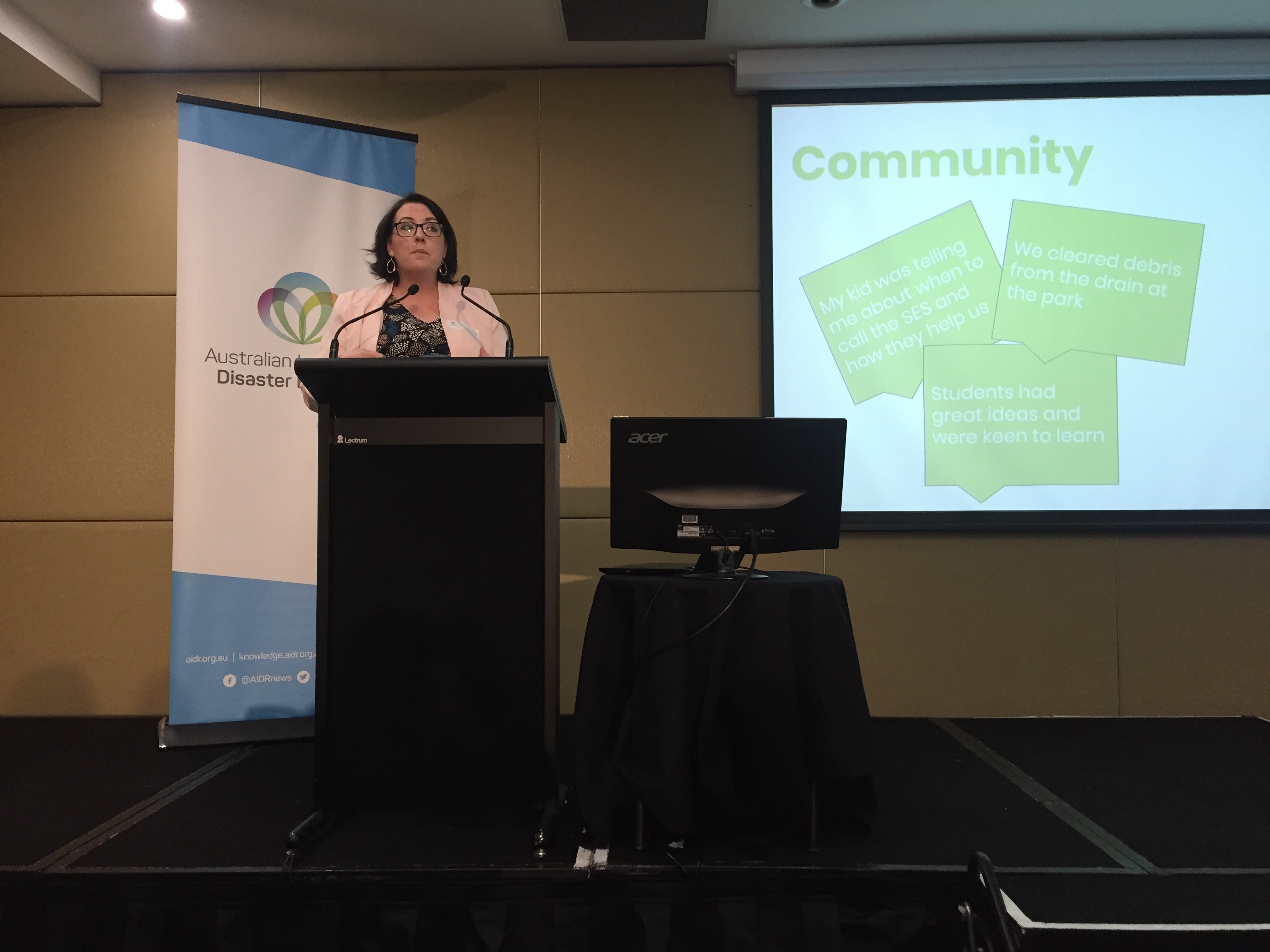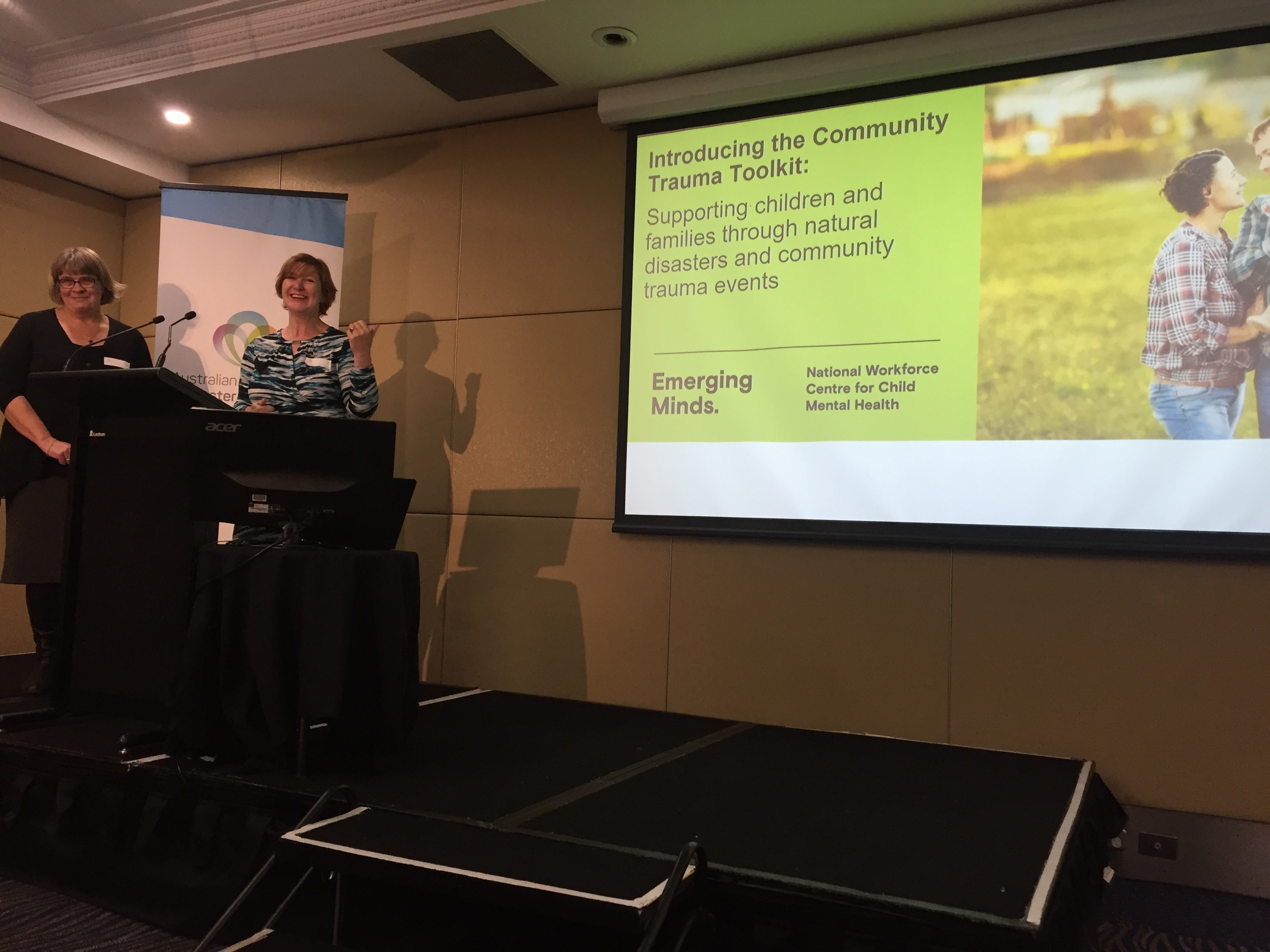Expanding the scope of disaster risk reduction
The second of seven Disaster Resilient Australia New Zealand School Education Network (DRANZSEN) forums to be held around Australia in 2019, explored effective models of disaster resilience education (DRE) to reduce risk and strengthen communities through student participation and partnership for learning.
Apply design thinking to collaboration
NSW Department of Education K-6 STEM Curriculum Advisor Barbara Ryan opened the forum by demonstrating the potential for learning partnerships between schools and external agencies using the five-step ‘design thinking’ process. Barbara provided examples from her time at St Ives Primary School in North Sydney
“The first step of design thinking is to empathise. When the NSW Rural Fire Service (NSW RFS) came to our school to share their experience of bushfire and how they rescue people and pets, it built our students’ understanding of fire and helped break down their misconceptions,” Ms Ryan said.
After speaking with the volunteers, the students then ideated their most creative solutions to bushfire – underground bunkers, drone firefighting, ember-seeking robots, water reservoirs under the forest trees – and pitched them to the NSW RFS volunteers to understand why the ideas would or wouldn’t work.
Warrimoo’s continuing commitment to community resilience
Warrimoo Public School in the NSW Blue Mountains raised awareness of bushfire risk and developed the school as a safe place for the community during emergency through their Bushfire Ready Program. Warrimoo Public School Principal Tony Jeff and Warrimoo RFS volunteer Peter Randall said agencies and schools need to be genuine about collaboration, partnerships and authentic learning.
The Bushfire Ready Program followed a bushfire in 2014 that threatened the school grounds and is still in the living memory of the students. Through enabling students to develop their understanding of fire, the program sought to reduce fear and anxiety about fire in the school community.
“Now we are seeing kids having discussions when they see smoke in the mountains about hazard reduction burning and why it happens. They’re distinguishing risk reduction from an emergency,” Mr Jeff said.
Technology promotes safe behaviour outside school hours
When Mount St Thomas Public School lost a student in a tragic accident near a stormwater drain in early 2017, the community was distraught.
 Last year teacher Jen Faulconbridge introduced a learning unit to explore how technology can keep children safe during the school holidays. Using Lego WeDo and Dash Robotics, the students designed a model vehicle to
Last year teacher Jen Faulconbridge introduced a learning unit to explore how technology can keep children safe during the school holidays. Using Lego WeDo and Dash Robotics, the students designed a model vehicle to
assist the local NSW SES crew during a storm or flood emergency in the Wollongong region.
To provide an authentic audience and feedback for their project, NSW SES volunteers were invited into the classroom to discuss storm and flood safety with students and discuss how their model vehicles could be used during an emergency.
“The SES volunteers came in and sat on the floor with the kids and asked questions. Every child in the room got feedback from them. Real audience, real purpose and real feedback drives learning for kids,” Ms Faulconbridge said.
Communicating flood risk in Hawkesbury-Nepean Valley classrooms
With the Insurance Council of Australia identifying the Hawkesbury-Nepean region as the most flood-exposed region in NSW, a team from the University of Western Sydney (UWS) and Infrastructure NSW recognised an opportunity to educate the community about their risk.
Designed for secondary students (Year 8), the team has developed the Hawkesbury-Nepean Valley Flooding Geography School Curriculum Resource – aligned with both the Australian Curriculum and NSW Geography Syllabus – to facilitate inquiry-based learning and consult with students on this important topic.
“This is an authentic, real-life problem, so we are flipping it on its head and saying to the students, ‘kids, what can we do about this?’ We want to get them thinking about this and owning it as an issue that affects them,” said UWS researcher Dr Erin Mackenzie.
Community Trauma Toolkit to equip teachers 
Nicola Palfrey and Annabel Axford from Emerging Minds introduced the Community Trauma Toolkit at the DRANZSEN Forum, explaining how this extensive suite of resources can be used by teachers to support students and the wider school community.
Grouped for different audiences – including first responders, GPs, parents, teachers and community leaders – the free online resources offer guidance to support young people and adults experiencing trauma related to natural hazard impacts, emergencies and other challenging events. Emerging Minds is targeting schools, alongside NGO’s and faith-based groups, to make sure the toolkit is reaching the people who will deliver support in their own communities, including those responsible for providing emotional support to children.

“There is a lot of good will out there, but also fear, about talking or supporting children during disaster. Our toolkit provides research-endorsed information from us to back them,” Ms Palfrey said.
Empathy and engagement emerged as central themes at the second Disaster Resilient Australia New Zealand School Education Network (DRANZSEN) Forum for 2019 in Sydney on June 3.
This was the second of seven DRANZSEN forums to be held around Australia in 2019, exploring effective models of disaster resilience education (DRE) to reduce risk and strengthen communities through student participation and partnership for learning.
Apply design thinking to collaboration
NSW Department of Education K-6 STEM Curriculum Advisor Barbara Ryan opened the forum by demonstrating the potential for learning partnerships between schools and external agencies using the five-step ‘design thinking’ process. Barbara provided examples from her time at St Ives Primary School in North Sydney
“The first step of design thinking is to empathise. When the NSW Rural Fire Service (NSW RFS) came to our school to share their experience of bushfire and how they rescue people and pets, it built our students’ understanding of fire and helped break down their misconceptions,” Ms Ryan said.
After speaking with the volunteers, the students then ideated their most creative solutions to bushfire – underground bunkers, drone firefighting, ember-seeking robots, water reservoirs under the forest trees – and pitched them to the NSW RFS volunteers to understand why the ideas would or wouldn’t work.
Warrimoo’s continuing commitment to community resilience
Warrimoo Public School in the NSW Blue Mountains raised awareness of bushfire risk and developed the school as a safe place for the community during emergency through their Bushfire Ready Program. Warrimoo Public School Principal Tony Jeff and Warrimoo RFS volunteer Peter Randall said agencies and schools need to be genuine about collaboration, partnerships and authentic learning.
The Bushfire Ready Program followed a bushfire in 2014 that threatened the school grounds and is still in the living memory of the students. Through enabling students to develop their understanding of fire, the program sought to reduce fear and anxiety about fire in the school community.
“Now we are seeing kids having discussions when they see smoke in the mountains about hazard reduction burning and why it happens. They’re distinguishing risk reduction from an emergency,” Mr Jeff said.
Technology promotes safe behaviour outside school hours
When Mount St Thomas Public School lost a student in a tragic accident near a stormwater drain in early 2017, the community was distraught.
Last year teacher Jen Faulconbridge introduced a learning unit to explore how technology can keep children safe during the school holidays. Using Lego WeDo and Dash Robotics, the students designed a model vehicle to assist the local NSW SES crew during a storm or flood emergency in the Wollongong region.
To provide an authentic audience and feedback for their project, NSW SES volunteers were invited into the classroom to discuss storm and flood safety with students and discuss how their model vehicles could be used during an emergency.
“The SES volunteers came in and sat on the floor with the kids and asked questions. Every child in the room got feedback from them. Real audience, real purpose and real feedback drives learning for kids,” Ms Faulconbridge said.
Communicating flood risk in Hawkesbury-Nepean Valley classrooms
With the Insurance Council of Australia identifying the Hawkesbury-Nepean region as the most flood-exposed region in NSW, a team from the University of Western Sydney (UWS) and Infrastructure NSW recognised an opportunity to educate the community about their risk.
Designed for secondary students (Year 8), the team has developed the Hawkesbury-Nepean Valley Flooding Geography School Curriculum Resource – aligned with both the Australian Curriculum and NSW Geography Syllabus – to facilitate inquiry-based learning and consult with students on this important topic.
“This is an authentic, real-life problem, so we are flipping it on its head and saying to the students, ‘kids, what can we do about this?’ We want to get them thinking about this and owning it as an issue that affects them,” said UWS researcher Dr Erin Mackenzie.
Community Trauma Toolkit to equip teachers
Nicola Palfrey and Annabel Axford from Emerging Minds introduced the Community Trauma Toolkit at the DRANZSEN Forum, explaining how this extensive suite of resources can be used by teachers to support students and the wider school community.
Grouped for different audiences – including first responders, GPs, parents, teachers and community leaders – the free online resources offer guidance to support young people and adults experiencing trauma related to natural hazard impacts, emergencies and other challenging events. Emerging Minds is targeting schools, alongside NGO’s and faith-based groups, to make sure the toolkit is reaching the people who will deliver support in their own communities, including those responsible for providing emotional support to children.
“There is a lot of good will out there, but also fear, about talking or supporting children during disaster. Our toolkit provides research-endorsed information from us to back them,” Ms Palfrey said.
These initiatives strengthen the relationship between emergency services and the education sector, with each organisation expanding the scope of disaster risk reduction to engage with young people.


